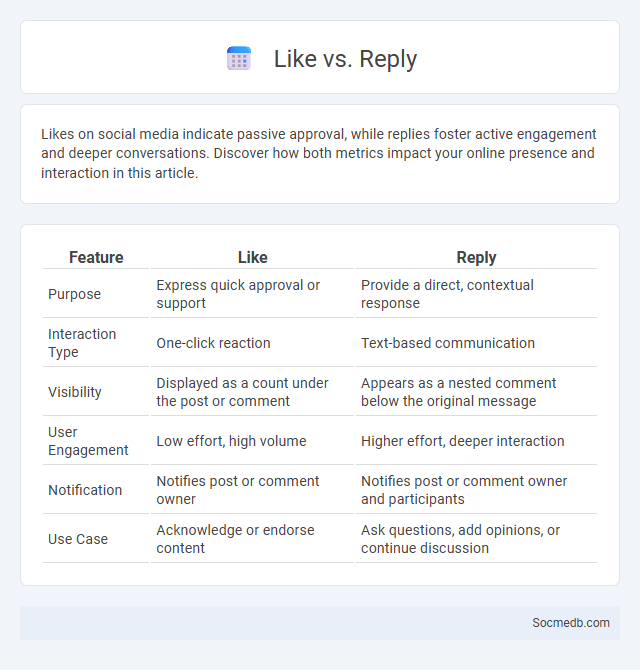
Photo illustration: Like vs Reply
Likes on social media indicate passive approval, while replies foster active engagement and deeper conversations. Discover how both metrics impact your online presence and interaction in this article.
Table of Comparison
| Feature | Like | Reply |
|---|---|---|
| Purpose | Express quick approval or support | Provide a direct, contextual response |
| Interaction Type | One-click reaction | Text-based communication |
| Visibility | Displayed as a count under the post or comment | Appears as a nested comment below the original message |
| User Engagement | Low effort, high volume | Higher effort, deeper interaction |
| Notification | Notifies post or comment owner | Notifies post or comment owner and participants |
| Use Case | Acknowledge or endorse content | Ask questions, add opinions, or continue discussion |
Understanding Likes: What They Mean
Likes on social media represent user engagement and can indicate content popularity, audience preferences, and brand visibility. Analyzing the number and patterns of likes helps marketers tailor strategies to increase reach and foster community interaction. Quality content that resonates emotionally or offers value tends to generate higher likes, influencing algorithm-driven exposure.
The Purpose of Replies in Digital Conversations
Replies in digital conversations serve to clarify, expand, or challenge the original message, fostering deeper engagement and understanding within social media platforms. Your participation through replies encourages dynamic interaction, builds community, and enhances the flow of information across networks. This two-way communication is essential for creating meaningful online dialogues and maintaining active, responsive social environments.
Comment Threads: Building a Community Dialogue
Comment threads foster dynamic community dialogue by enabling users to engage in real-time conversations, share diverse perspectives, and deepen connections around shared interests. Platforms like Facebook, Instagram, and Reddit utilize threaded comments to organize discussions, enhance clarity, and encourage meaningful interactions among participants. Effective moderation and prompt responses within comment threads strengthen trust, promote respectful exchanges, and cultivate vibrant online communities.
Like vs Reply: Key Differences
Likes on social media serve as quick endorsements, showing approval or appreciation for content without requiring a detailed response. Replies foster deeper engagement by enabling users to share thoughts, ask questions, or start conversations directly related to the post. Your choice between liking and replying impacts social media dynamics, shaping interactions and the visibility of your digital presence.
Engagement Impact: Comments vs Likes
Comments on social media generate deeper engagement by fostering conversations and building community, while likes serve as quick expressions of approval that boost content visibility. Your posts with higher comment rates often experience greater reach due to platform algorithms prioritizing meaningful interactions. Encouraging comments can significantly enhance your social media impact by creating authentic connections and sustained user interest.
When to Like, Reply, or Start a Comment Thread
Engage with social media posts by liking content that resonates or supports your interests, ensuring quick acknowledgment without overwhelming notifications. Reply to questions or statements that invite direct interaction, fostering meaningful conversations and strengthening relationships. Start a comment thread when introducing new ideas, asking open-ended questions, or encouraging diverse opinions to stimulate deeper engagement and community building.
Analyzing User Behavior: Likes, Replies, and Threads
Analyzing user behavior on social media involves examining metrics such as likes, replies, and threads to understand engagement patterns and content resonance. Likes indicate passive approval, while replies provide insights into user sentiments and foster interactive discussions. Threads reveal conversation depth and community involvement, helping platforms optimize content delivery and enhance user experience.
The Role of Replies in Social Media Interaction
Replies play a crucial role in social media interaction by fostering direct communication and engagement between users, enhancing the visibility of conversations within threads. Your active participation in replying to comments encourages community building and strengthens connections, promoting a dynamic exchange of ideas and opinions. Efficient use of replies boosts algorithmic favorability, increasing content reach and user interaction across platforms like Twitter, Instagram, and Facebook.
Comment Thread Etiquette and Best Practices
Engaging respectfully in social media comment threads enhances online interactions and fosters positive community building. You should avoid personal attacks, stay on topic, and use clear, concise language to facilitate meaningful discussions. Promptly addressing questions and acknowledging diverse viewpoints encourages constructive dialogue and mutual respect.
Maximizing Engagement: Choosing the Right Response
Maximizing engagement on social media requires choosing the right response that resonates with your audience's interests and emotions. Personalizing replies and addressing comments promptly boosts interaction and strengthens your community presence. Your thoughtful responses encourage ongoing dialogue, increasing visibility and fostering brand loyalty.
 socmedb.com
socmedb.com